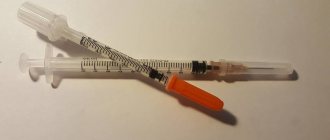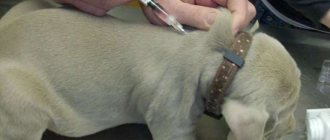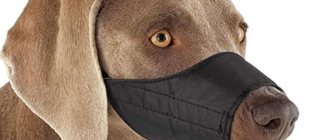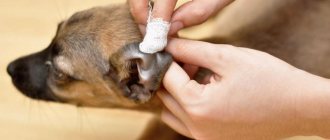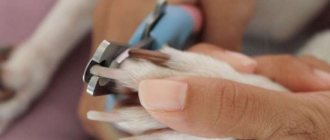Dogs, like people, get sick too. The owner begins to worry, and for good reason: sometimes a mild disease develops into a complicated one, where serious intervention cannot be avoided. In this case, contacting the veterinarian ends with giving an injection. Further treatment is usually lengthy, and then you need to decide whether to go to the doctor every day or find out how to give the dog an injection at home yourself. We invite you to find out everything about this to help your faithful friend recover!
In what cases is the injection given?
When a disease is detected, veterinarians often prescribe intramuscular injections. After all, these procedures allow you to inject a solution into soft tissues, from where it enters the blood in a matter of seconds. In addition, the medicine does not come into contact with the walls of the gastrointestinal tract, which is important for diseases of the digestive system.
The ability to give an injection to your dog (intramuscularly, subcutaneously) may be required if:
- the need to immediately administer the medicine;
- inability to contact a veterinarian;
- long course of treatment.
Remember, some injections can only be administered by a veterinarian. For example, home vaccination is not recognized by health authorities. The vaccine must be administered in the clinic and confirmed by a signature and stamp on the veterinary passport.
Necessity
It happens that there is simply no opportunity to contact an experienced specialist. And the future life of the pet (or, even worse, the pet and her litter) will depend on the timely administration of the drug. Many people at such a moment can become confused and the outcome of such stories is very disastrous - from the death of a dog to the death of the entire litter.
But having an understanding of the procedure and the ability to cope with one’s own fear, a person is able to make the necessary injection for its administration.
Preparing and restraining the dog
Before the injection, you need to prepare a syringe and medicine, and think through your actions. Fussiness and excitement frighten the dog, causing its muscles to tense. When an animal is in this state, it is more difficult for a person to insert a needle or squeeze the syringe plunger. In addition, the risk of complications after the injection increases.
The best time for injections is after a walk and eating. During this period, the animal is calm and relaxed. But some injections are given only before meals or at certain times of the day. In this case, you must act strictly according to the instructions.
Intramuscular injection, even in a small dog, requires secure fixation. For dwarf decorative breeds, bags are sold in which it is convenient to immobilize the pet with only one leg out. The animal can also be restrained by wrapping it in a large terry towel.
The mouth of a medium to large dog is always secured with a muzzle or an elastic bandage. Next, the assistant holds the pet's head and pinches its body with its legs. Another way is to tie the animal by the collar to any stable object.
Setting up the injection in stages
Regardless of your internal state, be confident at least externally. Panic on the part of the owner is quickly transmitted to the four-legged friend. Due to fear, the animal's muscles will be tense, which will make the procedure very painful. Choose a time when the dog is most relaxed, that is, immediately after feeding or a long walk.
Carefully read the following instructions on how to properly give injections to dogs:
- Lay the animal on its side, asking a helper to hold its head and forelimbs. Representatives of large breeds can be left in a standing position. In this case, the assistant must fix the dog by holding it by the collar. Avoid sudden movements that could cause injury.
- Wrap one hand around your pet's back paw and gently massage his thigh. Make sure he is relaxed.
- While holding your paw, take the syringe in your free hand. No pre-treatment of the working surface is required. Dog leather has a natural antibacterial layer.
- Having found the softest muscle, position the syringe at an angle of 90° and insert it into the upper thigh 2/3 the length of the needle. Keep your other hand directly under your hip. This will prevent changes in the position of the muscle.
- Gently press the plunger and slowly inject the drug, maintaining the same injection rate.
- Smoothly pull out the needle, holding it at the base, and lightly massage the thigh.
- Be sure to praise the dog for his courage, regardless of the actual picture. If there are no contraindications, treat your pet with a treat.
Please note that you cannot inject more than 5 ml at a time. This rule applies to animals of any size. If the dosage exceeds the specified value, divide it into several injections and inject them into different muscles.
Intramuscular injection in the thigh
Injecting the drug into the muscle allows you to quickly deliver the medicine to the diseased organ and avoid irritation of the walls of the digestive system. Therefore, such procedures are prescribed when long-term course treatment of serious animal diseases is necessary.
Step-by-step instructions allow you to correctly and quickly inject the medicine into a dog’s muscle.
Selecting a syringe
The insulin syringe is suitable for injections in puppies and miniature breed dogs. Its thin needle easily and almost imperceptibly enters the muscle tissue.
Injection with an insulin syringe is prohibited when injecting a solution with sediment or oily consistency. Such liquid can clog the narrow hole of the needle.
The 2 ml syringe is equipped with a thin needle that can reach the muscle layer of a medium-sized dog. Therefore, when prescribing 3-5 ml of medication, you can transfer it to a larger volume instrument.
A 5-ml syringe is used to administer the medicinal solution to large and giant breed dogs. Its long needle reaches the deep muscle layers and distributes the drug evenly.
We collect medicine
Examine the ampoule. The name and expiration date of the drug should be clearly visible on it. Shake the container if a sediment has formed or heat it in the palm of your hand if it has been stored in the refrigerator.
Wash your hands, prepare alcohol and sponges for disinfection. Run a special nail file over the ampoule, and then open it with a movement away from you. Inject the liquid into the syringe through the hole in the needle.
Make sure the dosage is measured correctly. To do this, it is better to use syringes with a clearly marked scale. Lift the tool with the needle up and release all the air from it.
Determining the injection site
The best sites for intramuscular injection are the thighs. There are no large blood vessels or nerve endings in this part of the body, and the bone is far from the skin.
Knowing that you need to inject your dog in the hip area, feel this area while brushing the fur. While the dog is relaxed, evaluate the condition of the skin, the thickness of the muscle, and the distance to the bone.
Dosage and rate of administration
The veterinarian determines the dosage of the medicine, taking into account the severity of the dog’s condition and its weight, namely:
- up to 2 kg – 1 ml;
- 2-10 kg – 2-3 ml;
- 10-30 kg – 3-4 ml;
- heavier than 30 kg – 5-6 ml.
The larger the volume of the medicine, the slower it needs to be injected into the muscle. So, each milliliter of solution should enter the tissue in 2-3 seconds.
Rules
Before understanding the main aspects of this procedure, let's find out why you need to learn how to give your pet an injection yourself.
Causes:
- In the most dire cases, an injection can save the life of a four-legged friend. The further condition of the animal depends on the time of administration.
- Saving money on transporting the animal to the clinic for injections provided by veterinarians, and on the injections themselves.
- If you have such a skill, then you can safely go on various trips without fear that the trip will be disrupted due to your pet’s illness.
- For sensitive dogs, it will be better if the owner himself does the unpleasant procedure, and not a stranger.
What are the basic rules:
- It is necessary to perform injections with sterile syringes.
- Don’t forget about personal hygiene: wash your hands thoroughly.
- Use disposable gloves for each injection.
- You also need to remember about the expiration date of the drug: use only fresh ones.
- You cannot mix several solutions in one syringe at once; by-products when mixed can harm your pet.
In addition, dogs are very good at detecting the owner’s mood: in order for the procedure to be less painful, it is important to be in a calm state.
How to give a subcutaneous injection at the withers
The subcutaneous fat layer is penetrated by many small blood vessels. Therefore, after injection, the medicine penetrates the circulatory system slowly and evenly. Subcutaneous injections allow you to avoid pressure surges, a sharp immune reaction, and severe pain. They are recommended for the treatment of adult dogs, puppies, pregnant and weakened animals.
The best place for subcutaneous injections is the withers. This is the name of the skin between the shoulder blades. It is designed by nature to carry puppies with the teeth, as well as for protection during fights with other predators. Rough, insensitive skin allows you to give an injection painlessly. But at the same time, an inexperienced owner can break or bend the syringe needle.
The algorithm for subcutaneous administration of the drug is as follows:
- draw the drug into the syringe;
- pinch the skin into a fold and pull it upward;
- make a puncture with a needle at an angle of 45 degrees;
- slowly inject the medicine while pressing down on the plunger.
Make sure that the needle does not pierce all the way through the fold. Then the medicine will not get into the fat layer. Remember, the dog is not given a subcutaneous injection in the area under the collar, so that the puncture site does not become injured, dirty or inflamed.
conclusions
When giving injections, it is important to prepare yourself, read the instructions, correctly calculate the dose, after weighing the dog, choose and not confuse the method of injection and the place of its administration. The easiest way to give an injection is subcutaneous injection! Do not do intravenous injections without at least some basic medical skills or if you doubt yourself. Be aware of possible side effects.
Please follow and like us:
Nikitin Sergey
I write about dogs based on the experience and knowledge gained during my studies as a veterinarian, work in my specialty, and simply from observing my pets.
Intravenous injection
Intravenous injections are often prescribed when severe illnesses are detected. Such procedures can be carried out while the animal is unconscious. When the medicine is administered directly into the circulatory system, the absorption of the active components of the medicine improves and the speed of onset of the therapeutic effect increases.
Intravenous injections are a complex procedure. The person must not only get into the vein, but also keep the needle there until the medicine is completely administered. Many solutions for such injections are extremely irritating to soft tissue. And if they get into a muscle or under the skin, a dangerous inflammatory process appears in this place.
The veterinarian usually gives an injection in the forearm area. Before this, he cuts the hair there and disinfects the puncture site. The needle is inserted with the point up, carefully piercing the skin and then the wall of the vein. If the hit is successful, dark venous blood enters the syringe. Next, the doctor advances the needle a few more millimeters and gently presses on the piston.
After administering the medication, the veterinarian compresses the puncture site with a sponge soaked in antiseptic. He carefully removes the needle, continuing to wipe the hole with cotton. This action prevents the development of hematoma.
Installation of a dropper
Veterinarians can tell you how to put an IV on a puppy or dog, but they do not recommend doing this procedure at home. When administered by drip, the drug should enter the vein slowly. During this time, the pet must be fixed in a motionless position or put into medical sleep.
If the animal is prescribed a long course of intravenous injections or drips, a catheter can be installed. This is the name of a device consisting of a needle and a short tube for connection to other medical devices. A dog can only be catheterized in a clinic setting.
General recommendations
To give your dog an injection and avoid complications, follow these recommendations:
- Do all manipulations with clear, confident movements, do not hesitate, do not fuss.
- Do not put drugs of different effects into one syringe. When they are mixed, the chemical structure of the liquid can become useless and even dangerous.
- Do not store an open ampoule. If there is any drug left in it, draw it into a new syringe, put a cap on the needle, and store it in the refrigerator.
- Do not touch the needle with your hands. If necessary, adjust the instrument by holding the plastic cannula.
- There should be no bruises, scratches, inflammation, redness, or rash on the skin at the puncture site.
Do not inject in the same place. Alternate left and right sides. Examine your hips and monitor for complications.
Common Mistakes
Owners often make mistakes that end up causing fear and damage to the animal’s health.
- The owners are worried and the excitement is transmitted to the dog.
- The animal did not relax, as a result of which it dodged the injection in every possible way.
- The owner did not choose in advance the place where the injection would be given and acted chaotically during the injection.
- The animal was shouted at and beaten before the procedure.
- There were many strangers in the room when the injection was administered.
Consequences of unsuccessful injections
Even a correctly administered injection injures tissues and causes pain. Therefore, a sharp withdrawal of the paw is a normal reaction of the pet.
Do not worry when you see a drop of blood on your skin or in a syringe. Press the puncture site with a cotton swab moistened with an antiseptic. To stop minor bleeding, apply a cold object to the puncture site.
Hematomas appear due to bleeding under the skin. Applying an iodine grid will help correct the situation. If a dog limps or pulls its paw after an intramuscular injection, a nerve node has been affected. If the pet's condition does not return to normal within 2-3 hours, it is necessary to take the animal to the veterinarian so that he can install a novocaine blockade.
